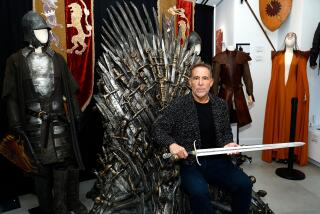$3.4-Million Sculpture Sale Sets Record for African Art : Auction: Some items in a Beverly Hills collection bring as much as 10 times their pre-sale estimates during brisk bidding at Sotheby’s in New York.
- Share via
NEW YORK — A Cameroon sculpture known as the “Bangwa Queen” sold for $3.4 million, a record for African art, in an auction of the Harry A. Franklin Family Collection on Saturday at Sotheby’s auction house.
Proceeds of the daylong sale totaled $7.1 million, making it the biggest African art auction in history and exceeding Sotheby’s most optimistic prediction by almost $2 million.
The auction of the Los Angeles-based collection was not an unmitigated success, however. While some items commanded as much as 10 times their pre-sale estimates, 123 of the 431 lots failed to sell.
“That is to be expected in such a big sale. There were more of the low-priced things than collectors wanted, but almost all of the great things brought great prices,” said Bernard de Grunne, director of Sotheby’s tribal arts department.
“The market for African art has been growing steadily for the past few years, and this sale proves that it is very healthy,” De Grunne said.
Competition for the “Bangwa Queen” erupted into a fierce telephone bidding war between anonymous clients. The price soon surpassed Sotheby’s estimate of $1.8 million, as well as the previous African art record of $2.08 million, set last July for a Benin bronze head.
“I didn’t expect it to go so high, but there were two very aggressive buyers,” De Grunne said.
The 32 1/2-inch-tall wood sculpture, which represents the dual female roles of earth-cult priestess and mother of twins, had been expected to steal the show, however. As the subject of a photograph taken in the ‘30s by Surrealist artist Man Ray and the cover piece of a catalogue for a major touring exhibition of Cameroon art, the “Queen” is one of the world’s most famous pieces of African art.
And this is not the first time the “Bangwa Queen” has run away with an auction. The expressive figure was the prize piece at the 1966 landmark auction of the Helena Rubenstein collection, where the late Harry A. Franklin bought it for about $26,000.
Franklin, who died in 1983, was a pioneering collector and dealer in the field of so-called primitive art. He bought his first piece in 1938 and with his wife, Ruth Franklin, opened a gallery in Beverly Hills in 1955. Their daughter, Valerie Franklin, joined the family business in 1970 and took over the gallery after her father’s death. She recently decided to sell the collection to launch a new career as a writer.
Harry A. Franklin was among the few collectors who started early enough to buy hundreds of good African pieces. His collection was highly regarded among scholars for its quality and provenance, or well-documented history of ownership that proves the art’s authenticity. The Cameroon material was considered the best in private hands.
About 500 collectors, dealers and curators attended the auction, which was billed as a major event for the African art market. Americans and Europeans did most of the buying, but Tokyo dealer Hiroshi Ogawa played an active part. His biggest purchase was a male figure, thought to have been carved as the mate of the “Bangwa Queen.”
When auctioneer Robert C. Woolley knocked down the male sculpture at $300,000 (plus the standard 10% buyer’s premium), he quipped: “That’s $300,000 for sexism.”
“That was a great buy,” said Tamara Northern, a scholar of Cameroon art and professor at Dartmouth College. “His true worth will be recognized in the future.”
Among other top lots in the Franklin sale, a Bamileke mask brought $319,000, more than twice its high estimate of $150,000. A Mambila male ancestor figure valued at $25,000 to $35,000 commanded the astonishing price of $264,000. A few minutes later a telephone bidder paid $176,000 for a Cameroon figure valued at $30,000 to $40,000.
The sale lagged at times and prices dipped as low as $275, the amount paid for a wood neck rest, but the auction was generally a tense affair punctuated by grumbling and applause.
More to Read
The biggest entertainment stories
Get our big stories about Hollywood, film, television, music, arts, culture and more right in your inbox as soon as they publish.
You may occasionally receive promotional content from the Los Angeles Times.










